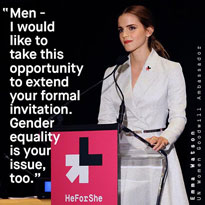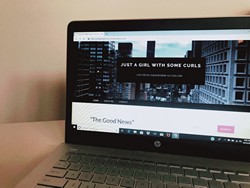I am a feminist, and I recently participated in a campaign where other feminists and I attempted to get male students at the University to take a pledge stating that they were “He For She.” The pledge was simply about making a commitment to stand for gender equality. However, there were a few male students who made excuses for not taking the pledge, and there was one in particular whom I will never forget.
This student declined to pledge with assurance. He looked us in the eyes and said, “I believe in gender equality, but not in…feminism.”
For three milliseconds I stood there, confused, and it was just enough time for him to make a getaway.
I will always regret this lapse in my motor skills, because I never got the chance to enlighten him. I did not get to tell him that a feminist is someone who believes in gender equality, and that the two are synonymous.
For centuries, the fight against gender discrimination and gender-bias has been a burden on the shoulders of those it mainly affects: women. I have come to realize that this is due to the fact that men, and some women, misunderstand the true definition of feminism.
According to a poll taken by YouGov in 2014, 75 percent of Americans do not consider themselves feminists. However, when asked if they believed that “men and women should be social, political, and economic equals,” 60 percent said yes.
So either the polls are wrong, which is unlikely, or somewhere in history the core definition of feminism was skewed in the minds of Americans. When a person says, “I am not a feminist,” they are also saying that they do not believe in gender equality, because according to the Merriam Webster Dictionary, feminism is “the belief that men and women should have equal rights and opportunities.”
Male readers, if I have enlightened you with the above definition, you now know what feminism truly means. Hopefully it has made you realize that all your life you have unknowingly been a feminist.
If this is the case, then I ask that you widen your inherent feminist beliefs towards the billions of women outside of your life. Think of all of the women and girls around the world who are discriminated against due to the simple fact that they were born female.
If you do not have the creative power to imagine, let me draw it out for you in statistics: According to the Government Printing Office, two-thirds of children denied education are girls. According to the International Labor Force Office of Geneva, women and girls make up 98 percent of the world’s trafficking victims. According to the National Institute of Justice and the Centers for Disease Control & Prevention, one out of every six American women has been the victim of an attempted or completed rape in her lifetime. Among all victims of rape, about nine out of ten are female.
Women alone can no longer do all the heavy lifting against gender bias and gender hatred. “It’s important for men to understand feminism so that they can recognize the privilege they receive and end male perpetuation of sexism and misogyny,” explained Gracie Zwernemann, a senior English and education student.
We are not asking for white knights to charge in and lead the feminist movement. We simply need more men to stand in solidarity with women in the fight for gender equality.
Now that you can imagine the injustices that women are facing worldwide, I hope you’re ready to take action against them, but don’t get overwhelmed, because I made you a list:
1. Join a local girl group:
Do some research and find a local organization in your community that advocates for women and girls. You might have to do a little leg work, but that’s okay, because in the grand scheme of things, you’re potentially saving lives. Make a few phone calls and find out meeting times. See if there are any upcoming events and invite individuals from your “bro squad” to go with you.
2. Join a local guy group:
There is one particular organization called Men Can Stop Rape (MCSR). This group has been around for decades. Their mission is to “mobilize men to use their strength for creating cultures free from violence, especially men’s violence against women.”
They have a host of events, projects, and campaigns that men like you can get involved in. They also provide a convenient list of other men’s anti-violence organizations around the U.S.
3. Buy a t-shirt:
If you would like to start out small, then do something as simple as buying a t-shirt. You might have seen them before, but there are powerful t-shirts that say, “This is what a feminist looks like.” Google that phrase and you will find many sites you can purchase your t-shirt from. Spending less than $24 would allow you to showcase your feminism to the world. My hope is that this will cause people to look at you and consider that men can be feminists too.
4. Get some exercise:
Every year the United Nations hosts a march for gender equality in New York City on International Women’s Day. Next year you could be one of the thousands of men and women who march through the streets of Manhattan in support of gender equality. You could make a colorful sign and wear your “This is what a feminist looks like” t-shirt, and who knows, maybe you’ll end up on television.
With all of that being said, good luck in your endeavors as a male feminist. I hope this guide helps you become a catalyst of change in the world. Be proud. Your commitment will better the lives of women and girls one less ignorant mind at a time, because in the wise words of Emma Watson, “Gender equality is not a women’s issue, it’s a human rights issue; it affects us all.”
IMAGE TAKEN from theinspirationroon.com




